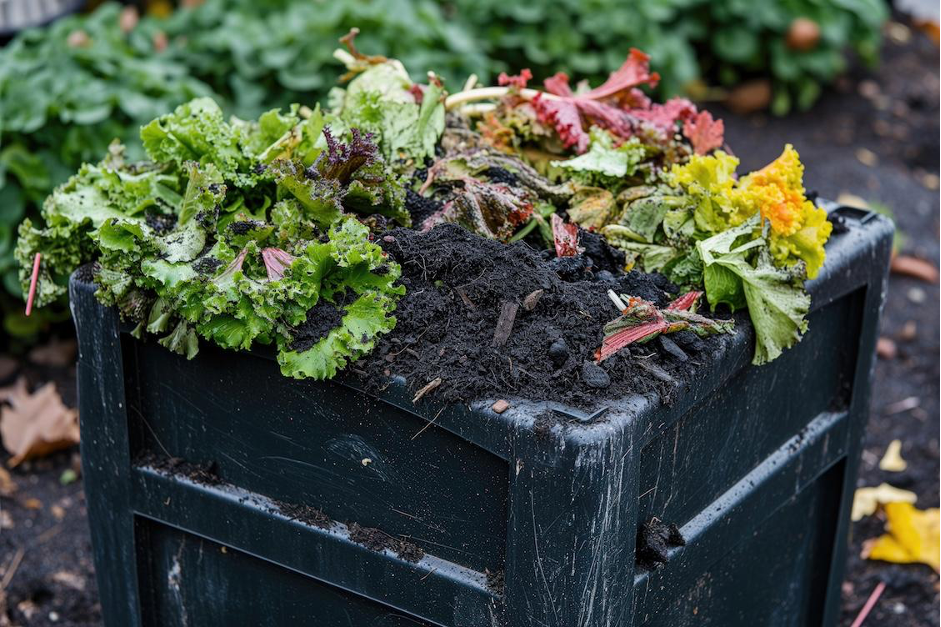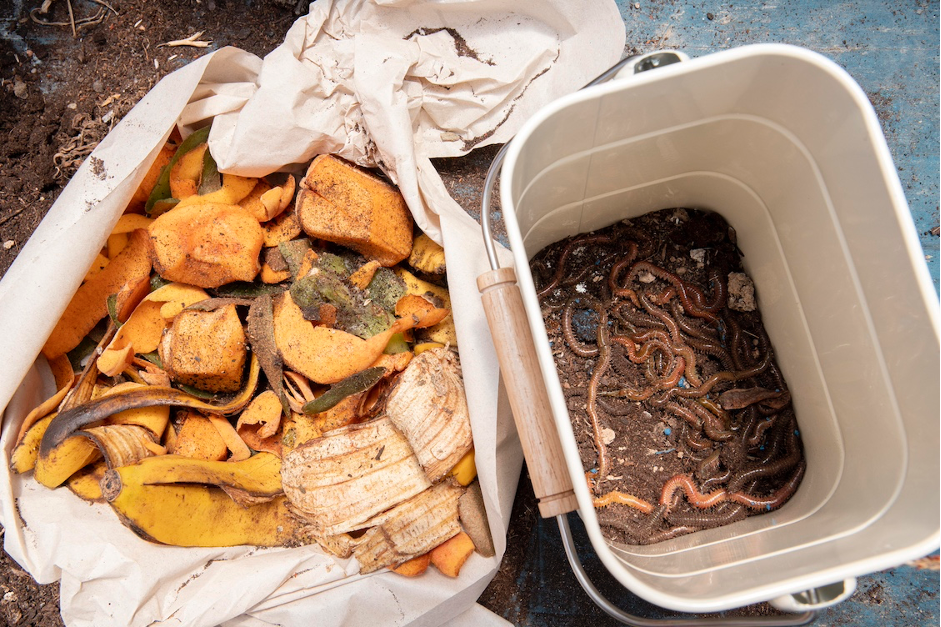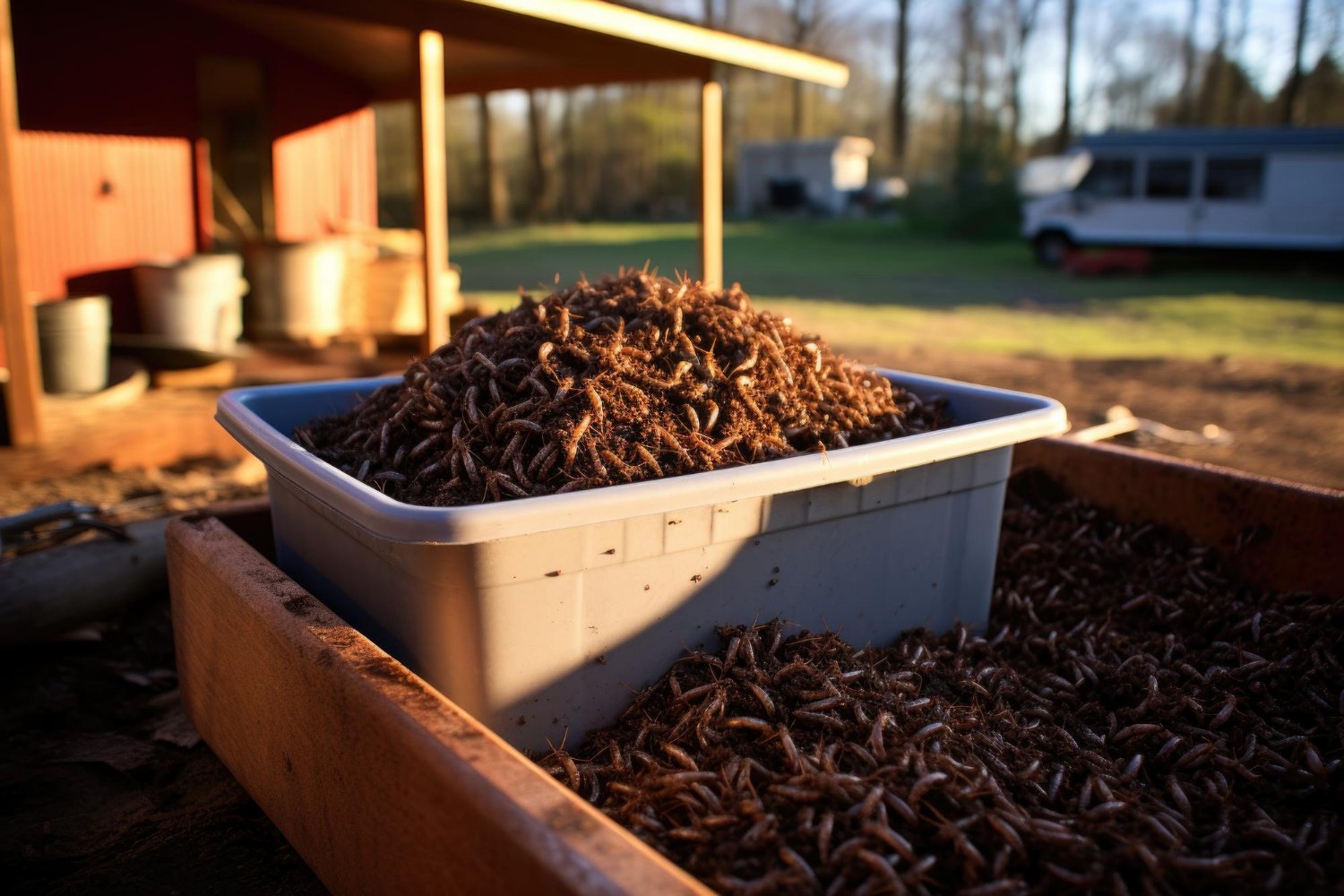 Composting worms need oxygen, but how much airflow do their bins need? While starting a worm bin is quite simple, the reasons for the bin design are more complicated. All worm bins need air holes, proper drainage, and suitable bedding. Without a proper design, a worm bin becomes a coffin for sick worms. And the smell! Thus, using a standard worm bin design is important to composting success. If you want to turn kitchen scraps into valuable fertilizer, find out about airflow in composting worm bins.
Composting worms need oxygen, but how much airflow do their bins need? While starting a worm bin is quite simple, the reasons for the bin design are more complicated. All worm bins need air holes, proper drainage, and suitable bedding. Without a proper design, a worm bin becomes a coffin for sick worms. And the smell! Thus, using a standard worm bin design is important to composting success. If you want to turn kitchen scraps into valuable fertilizer, find out about airflow in composting worm bins.
How Worms Breathe
Humans breathe through the mouth and nose, and into the lungs. Worms breathe through their skin. Oxygen diffuses from the air through the skin. Worms do not have lungs. So long as they have access to enough air and moist skins, they will breathe easily.
Worms make tunnels by eating their way through organic matter and soil. The tunnels allow air to flow. Tunneling also digs up the soil and makes it fluffier. Fluffier material has more airflow than compact material. Releasing European Night Crawlers (Super Reds) into the garden helps break up the soil, adds tiny air pockets and tunnels, and provides worm fertilizer.
Be careful when you place a bag of composting worms into a worm bin or the garden. You might be tempted to dig a hole, empty the worm bag, and cover it with soil or bedding. However, the worms will be deprived of oxygen if you do this. Some of them might not make it! Best to place them gently on the surface. They will dig their way down. Worms will move away from light, so sunlight or shining a light on them will encourage them to dig down quickly.
In the wild, a heavy rain saturates the soil and starts to fill up the worms’ tunnels. The worms cannot get enough air, so they crawl onto the surface. This is a perfect feeding time for birds and other worm-eating critters!
The worm bin is a small environment and as such, its lid protects it from rain. The worm bin needs to be maintained properly to keep the worms productive. Deprive them of oxygen and the worms will suffocate.
Good Worm Bin Design
A good worm bin generally has these attributes:
- A lid to keep out the rain and discourage predators
- Drainage holes at the bottom
- Air holes in the sides
- Room to fit enough bedding so the worms can move around
- Empty space above the bedding for air and to let the bedding/fertilizer mix get bigger
Worm bins for composting can be made from wood, plastic, old pallets, mesh wire, or cement blocks. See our video about making a worm bin from a tote.
The best type of worm composter is made from trays stacked one above another. Start with one tray for the bedding, worms, and scraps. When this tray is full, add another tray of bedding. Feed only in the top tray. The worms will migrate up, leaving perfect fertilizer in the lower trays. In this way, you can compost without the effort of separating worms from bedding. Uncle Jim’s Worm Farm carries several styles of tray-based worm bins.
Air Exchange
Airflow is needed in the worm bin. Just like us, worms generate carbon dioxide as part of their breathing process. They release CO2 out through their skins using diffusion. This carbon dioxide needs to go somewhere. If it builds up, it will deprive the worms of oxygen. So if you make your own worm bin, be sure to have plenty of air holes. A worm bin that you buy should already have sufficient air flow. Good air goes in, and bad air goes out.
In this context, diffusion means that chemicals move from an area of high concentration to lower concentration. Oxygen is more concentrated in the air than in the worm. Therefore, the oxygen spontaneously moves from the air, through the worm’s skin, into the worm. If the worm’s skin needs to be moist for this to work. Carbon dioxide waste is more concentrated in the worm than in the air. The CO2 naturally diffuses into the air.
When Things Go Wrong
You will know something is wrong if the worm bin has a foul odor. A healthy worm composting bin should have an “earthy” smell. If something stinks, you might not have enough air holes. It’s possible that the drainage holes are blocked, or there is something else wrong. Consult our worm bin odor guide if this comes up.
Treat your worms like living creatures – because they are living and breathing! These humble creatures will happily turn your kitchen scraps and garden waste into valuable fertilizer. Uncle Jim recommends Red Worms for composting, and European Night Crawlers for composting, fishing, and releasing into the garden. See our selection of convenient composting bins.









18 thoughts on “Airflow in Composting Worm Bins”
I always like to check out the different ways people use to get more air to their worms.
I haven’t indoor composted in years, but I am back at it! I designed my box using two storage bins with holes drilled into the bottom and sides of the top bin to allow for air through the sides and drainage from the bottom. My bedding consists of shredded paper, a little coffee grounds and some soil. I allowed kitchen scraps to marinade over a week before adding the worms. When I added the worms, I moistened the material as well. However, when I work up the next morning, the worms escaped from the bin holes and I had over 2 dozen worms on my kitchen floor! There were also larvae all around the perimeter of my bin, just on the inside… with MANY worms trying to escape; good thing I didn’t sleep in that morning, or all 1,000 worms may have escaped. yikes! I do not recall this ever happening… has anyone dealt with a similar situation? Any recommendations on what may be wrong, or what I can do to fix it? For now, I have my bin sitting outside where it is more acceptable if the worms escape. But, outside won’t work in the winter here.
Also, aside from covering new food items when they are placed into the bin, how often should one turn over a composting bin?
Thanks!
Hi Lynnea,
Newly placed worms haven’t settled in their new home yet and often start to explore. That’s why it’s often recommended to leave on a light at night: worms don’t like the light and will stay indoors. Most guides speak of needing to do this for a couple of nights, but I have also read several mentions of them needing up to a month to settle. I also saw someone saying that an additional factor could be that the new worms were raised on different material than what you offer (so maybe they are looking for the missing horse manure). It is often mentioned that worms born in your bin are better adapted to its specific circumstances.
I’m currently almost four weeks into my first bin. I kept the light on for the first two weeks. I accidentally forgot it one night but had no escapees. After a turned the light off I had a couple of nights of escapees: not all nights and not many (about five in total but a couple of them died because of it) , but enough to keep the light on again have a good study at what might be the problem. (Because I like my worms, but I have no appetite to have to go hunting for them every morning. Especially in my living room.)
So in your case I would say it’s most probable that your worms are exploring after a relocation, because they are so newly placed. While of course it’s important to make sure you have no negative bin conditions going on (so keep checking those too every 2-3 days – I know my bin was too dry in the first week, because I read so many warnings about a bin gettong too wet. I sprayed it, but after I also added a glass of water several times the worm gang seemed happier and more lively), this seems the most logical explanation at this point.
What kind of larvae were in the bin? You might want to consider reading up on binbugs and how to deal with them, and maybe place some fly mesh over your air holes if they’re big enough for other creatures to enter the bin.
Good luck!
Best wishes,
Marzy
The Netherlands
Thanks,lots of good info
My worms escaped once, not due to air holes, but because I blended my food scraps in a Vitamix Blender before feeding. I thought I was doing my worms a favor, but instead, the liquid scraps composted too quickly or perhaps fermented. When I discovered my precious worms had crawled out onto my bedroom carpet and many had died, I quickly removed the lid and I could feel the excessive heat my liquid scraps had created. They escaped due to the heat.
What size drill bit is best to use for ventilation holes in my new bin?
Thanks for all the good info! This is the first night with my new worm bin and after reading this I got out of bed to go and check on them and, sure enough, they were exploring! I turned the light on and they all started retreating through the burlap back into their bedding! Like catching children sneaking out at night! I’ll be leaving the light on for awhile. Thanks for saving my new Worms!
I’m newer to vermicomposting, my parents did when I was a kid and I forgot all about it. While we were stay-at-home during COVID-19 I was far more aware of all the scraps we were tossing in the garbage, so I started my own worm bin. At first I had a few escapees but the light helped and they settled in, I fold newspaper on the edges and I think it keeps them inside a little better as there isn’t an “easy out” I had a period where I had a ton of fruit flies, the worms weren’t eating fast enough it seemed. I bring a spoon and gently aerate the bin before I add new food, and I have found that digging away the corners/edges and placing the scraps then covering them with the dirt is best. I feed weekly or 2x/week whatever I have and they have already eaten almost everything from the previous feed. Now I have less fruit flies but I also put on the top (in the empty bin with loosely shredded newspaper) bin a small bowl of apple cider vinegar (covered with plastic wrap and holes) that attracts and drowns the little buggers. My worms are multiplying, I’m seeing lots of babies now when I gently stir. Haven’t made worm tea yet but it’s been 3 solid months so it’s time to try it. I’m on my 3rd level ready to add the 4th and final bin this week. Lots of good earth/worm droppings in there now =)
Can I add holes for ventilation while the worms are in the plastic bin? I am convinced I did not provide enough air holes when I placed the worms in the bin yesterday.
I started my worm bin in the spring this year for only about 200 red wiggler. In the beginning i did not know what i’m doing i set up my bin according to the video i watch drill hole in the bottom for drainage and on the side.Being a beginner i don’t know what i’m doing feed them too much with high moisture omg i have a lot of fruit flies and too wet I almost give up and want to get rid of my worm bin. But I add some pit moss and this time i start to understand and i found out that you don’t need to drill a drainage in the bottom. You just have to control the food you give to the worm. And now i have 3 worm bin already and i have harvested the worm casting already i have about 5 pounds because the worms multiply rapidly. I used to compost indoor too i have about 10 5 gallon bucket but now that i have my worm bin so far i only have one bucket.
does the use of a styrofoam bin help oxygenation?
How many worm for a 30 gallon bin ?
Hello Sandra;
You can fit up to 4,000 Red Composting worms comfortably in a 30 gallon bin with room for them to reproduce.
Uncle Jim’s Worm Farm
I’m starting with 3 5-gallon bin containing 100 worms each . Which is best: pulverized oyster shells or pulverized eggs shells. How much and how often do I the item?
Hello Jim;
Either is great and you can add both if you wish. You can add as much or as little as you wish, but you do not need a lot, as long as the worms get that grit in the soil, I would say to mix it in until you can sparsely see it in the bedding.
Uncle Jim’s Worm Farm
I am having issues with fruit flies. How can I get rid of the flies without hurting my worms? My husband is not crazy about me raising worms in our laundry room and the flies are making it difficult to sell him on the idea
Does the lid need air holes? I wanna stack my bins on top of each other.. I have 3/8 inch holes around the top of container, is that enough?
If you have holes around the top sides, that should be enough if you are stacking the bins.
Uncle Jim’s Worm Farm